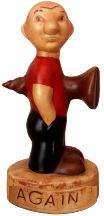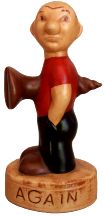 |
 The Virtual Corkscrew Museum's Weekly Newspaper |
 |
 |
 The Virtual Corkscrew Museum's Weekly Newspaper |
 |
|
Sunday July 8, 2007 |
Number 467 |
Hitching Posts
After reading the June 24 issue on "Outdoor Corkscrews", reader Bob Roger pointed out the hitching post shown in his new book Patented Ice Reducing Tools: An Identification Guide for Hand-Held Picks, Chippers, Crushers, and Shaves (figures A64 & A69).
Reverdy B. Stewart of Warren, Pennsylvania applied for a patent for his "Compound Tool" on December 31, 1889.
Although the main purpose of Stewart's patent was as a hitching device for horses, he combined it with a hammer, wrench, or hatchet and a scraper or pick for removing stones from horse feet.
The head has a screw for threading the tool into a fence, tree, or plank - thus a portable hitching post. We suppose a thirsty horseman could have utilized this as a corkscrew in a pinch.
U. S. Patent No. 418,541 was granted December 31, 1889.
Stewart received a second patent for "Portable Hitching Post" on September 22, 1891 (No. 460,094). In this patent he notes that the tool could be "a convenient appliance for many other purposes."
A hitching-post reminiscent of a corkscrew appears in Edmund C. Lemerand's U. S. Patent No. 906,438 of December 8, 1908.
The Monroe, Michigan resident gives a rather detailed explanation of screwing the device into the ground and then pushing the top down to secure the side anchoring bits.
Lemerand wrote "...which when in use is so firmly anchored that a horse attached to the post can not dislodge the post."
Note: Bob's book was reviewed in the May 27, 2007 issue.
Cavalry Corkscrew
Reader Carroll Johnson spotted the long corkscrew fence post in the June 24 issue and submitted letters from the March, 1972 issue of the Barbed Wire Gazette. They were in response to the "Screwy Post" picture posted in a previous issue.
From Goodland, Kansas - "My first sight of these posts was in late 1951 after the Arkansas River had gone on a rampage. During the summer, the stream bed had changed and scoured out old channel beds long forgotten. These posts in Hamilton County, Kansas, were set with military precision and an approximate square of silent posts was all that remained of a once-lively horse corral near Fort Aubrey.
The use was obvious. The screw posts could be set firmly in any soil and removed quickly when necessary. Ropes were strung through the upper loops of the posts to fashion a corral. It was a simple matter to unscrew the posts, load them in a wagon, coil the ropes and move out. Why they were left is unknown. Maybe another flood covered the area with debris or in their hurry to leave the fort supplies were left behind. At least this has been standard military procedure ever since.
My second experience was very similar only closer to home. The second biennial report issued by the State Board of Agriculture for the years 1879 and 1880 shows the western tiers of Kansas counties as 'Unorganized Counties' and the largest city being Eagle Tail and some 800 Army camp followers. Eagle Tail was located west of historic Fort Wallace outside of the reservation limits. The present town of Wallace, the historical museum and the miliary cemetery, are interesting sidelights of the early days.
In the summer of 1968 while looking for wire in the creek beds and rubbish piles, it was my good fortune to again see the 'screwy' posts just as they had stood untouched for years.
According to my references, Fort Aubrey was active from September 1865 through April, 1866. Fort Wallace was established in September, 1865, and officially closed as a military fort on July 22, 1884. "
A letter from Hays, Kansas - "Regarding the 'screwy' fence post on page 28 in your Gazette, I have 3 of them, one around 6 ft., one around 2 ft. and one around 18" long.
North of Manhattan Kansas, there are miles of them still being used. They are used on 4-wire fences."
A letter from Spencer, Iowa - "I have a newspaper picture showing the 'Screw in Fence Post.' It shows posts about a rod apart with the military crawling under the wire. At the bottom of the picture the cutline reads 'This Drill Teahes Men How to Crawl Under Obstacles of Barbed Wire'."
Another reader wrote - "At Fort Riley, Kansas, there used to be an old Cavalry post. This is around thirty-five miles from where I was born and rased. An old Army sergeant told me what they were used for. When the Cavalry maneuvered or camped they would screw these posts in the ground and put ropes through the loops ... for a corral for their horses."
Carroll's Wife's Garden
Carroll Johnson purchased several of the Cavalry fence posts and put them to good use. He writes "I first encountered these posts on eBay from a dealer in South Dakota. I bought one. When we moved from Massachusetts to Kansas, I discovered another antique dealer carrying some in his 'yard art' junk area. We bought some more and now use them in the garden because they are able to support plants with dense growth and obviously, once in the ground, are stable. Once other gardeners learned of their historical importance in the area, they began to purchase them and use them in their gardens."
Battle of Britain
Our tether article reminded reader Carroll Johnson about Bert Miles story. Bert is an English collector of corkscrews. Carroll wrote "Bert Miles said in a discussion some years ago that he used to anchor the 'Spitfire' airplanes, when they were not being used at the edge of the runway with the dog tethers. He said otherwise the wind would cause them to collide and crash. Bert was active in the 'Battle of Britain'."
Figural Hitching Posts
While googling Hitching Posts patents, I got tangled in the web and came across several figural hitching posts. Not corkscrews but perhaps a few readers may find them of interest - maybe even start an additional collection!
A design patent by Roger S. Austin of Wallingford, Connecticut dated April 4, 1871.
Coincidentally, John E. Earle, the patent attorney for Austin, patented a corkscrew on June 23 1868:
One of the witnesses on the Earle patent was A. J. Tibbits who also appears as a Witness on the Austin patent.
In addition, Earle was the patent attorney for Alfred Sperry's May 28, 1878 patent.
U. S. Patent Number 83,899 issued November 10, 1869 to James Allison of Cincinnati, Ohio for a "Hydrant". Allison wrote "...when it is desired to convert the post into a hitching-post, the horse-head cap, fig. 5, may be substituted for the cap, B, and a nut, C, may be applied for working the valve..."
Herman Koeller's U.S. Patent 341,488, May 11, 1886
Charles Hanson's U.S. Patent 543,624, July 30, 1895
|
©2007 Don Bull, Editor |